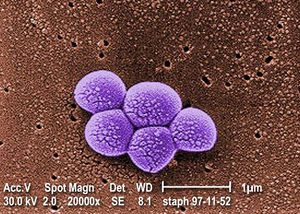Racial Disparities in MRSA Infections: Difference between revisions
| Line 3: | Line 3: | ||
<br>By Amir Johnson <br> | <br>By Amir Johnson <br> | ||
<br> Methicillin-Resistant Staphylococcus aureus, or MRSA for short, is a Gram-positive cocci-shaped (spherical) bacterium that measures approximately 1μm in diameter and forms clusters that are popularly described as being grape-like. <ref name=sadef>[https://www.ncbi.nlm.nih.gov/pmc/articles/PMC6148192/#B1 Lakhundi, S., & Zhang, K. https://doi.org/10.1128/CMR.00020-18 "Methicillin-Resistant <i>Staphylococcus aureus<i>: Molecular Characterization, Evolution, and Epidemiology." 2018. Clinical microbiology reviews, 31(4), e00020-18.]</ref> S. aureus is present on and within the bodies of many individuals asymptomatically, and as a result of this it often remains unnoticed. According to studies around 20% of people are persistent nasal carriers of S. aureus and around 30% are intermittent carriers, with the remaining 50% not carrying the bacterium. <ref name=sadef/> Other than within the nose, S. aureus can be commonly seen present on the skin, skin glands, guts, and a variety of mucous membranes. This presence within the body is referred to as colonization, and it significantly increases the chances of acquiring an infection by providing a reservoir of the pathogen. <ref name=sadef/> In most cases, the previously asymptomatic, commensal S. aureus that colonized the microbiome of individuals is responsible for their infection. <ref name=mrsaresevoir> [https://www.tandfonline.com/doi/abs/10.5172/conu.13.1.38 Rhonda Griffiths, Ritin Fernandez, Elizabeth Halcomb "Reservoirs of MRSA in the acute hospital setting: A systematic review" 2002. Contemporary Nurse, 13:1, 38-49] </ref> <br> | <br> Methicillin-Resistant Staphylococcus aureus, or MRSA for short, is a Gram-positive cocci-shaped (spherical) bacterium that measures approximately 1μm in diameter and forms clusters that are popularly described as being grape-like. <ref name=sadef>[https://www.ncbi.nlm.nih.gov/pmc/articles/PMC6148192/#B1 Lakhundi, S., & Zhang, K. https://doi.org/10.1128/CMR.00020-18 "Methicillin-Resistant <i>Staphylococcus aureus<i>: Molecular Characterization, Evolution, and Epidemiology." 2018. Clinical microbiology reviews, 31(4), e00020-18.]</ref> S. aureus is present on and within the bodies of many individuals asymptomatically, and as a result of this it often remains unnoticed. According to studies around 20% of people are persistent nasal carriers of S. aureus and around 30% are intermittent carriers, with the remaining 50% not carrying the bacterium. <ref name=sadef/> Other than within the nose, S. aureus can be commonly seen present on the skin, skin glands, guts, and a variety of mucous membranes. This presence within the body is referred to as colonization, and it significantly increases the chances of acquiring an infection by providing a reservoir of the pathogen. <ref name=sadef/> In most cases, the previously asymptomatic, commensal S. aureus that colonized the microbiome of individuals is responsible for their infection. <ref name=mrsaresevoir> [https://www.tandfonline.com/doi/abs/10.5172/conu.13.1.38 Rhonda Griffiths, Ritin Fernandez, Elizabeth Halcomb "Reservoirs of MRSA in the acute hospital setting: A systematic review" 2002. Contemporary Nurse, 13:1, 38-49] </ref> <br> | ||
<br> | <br> | ||
Revision as of 03:19, 8 April 2021
What is MRSA?

By Amir Johnson
Methicillin-Resistant Staphylococcus aureus, or MRSA for short, is a Gram-positive cocci-shaped (spherical) bacterium that measures approximately 1μm in diameter and forms clusters that are popularly described as being grape-like. [1] S. aureus is present on and within the bodies of many individuals asymptomatically, and as a result of this it often remains unnoticed. According to studies around 20% of people are persistent nasal carriers of S. aureus and around 30% are intermittent carriers, with the remaining 50% not carrying the bacterium. [1] Other than within the nose, S. aureus can be commonly seen present on the skin, skin glands, guts, and a variety of mucous membranes. This presence within the body is referred to as colonization, and it significantly increases the chances of acquiring an infection by providing a reservoir of the pathogen. [1] In most cases, the previously asymptomatic, commensal S. aureus that colonized the microbiome of individuals is responsible for their infection. [2]
Section 2
Include some current research, with at least one figure showing data.
Every point of information REQUIRES CITATION using the citation tool shown above.
Section 3
Include some current research, with at least one figure showing data.
<be>
Section 4
Include some current research, with at least one figure showing data.
Hospital-Associated MRSA
Community-Associated MRSA

Section 4
Include some current research, with at least one figure showing data.
References
- ↑ 1.0 1.1 1.2 Lakhundi, S., & Zhang, K. https://doi.org/10.1128/CMR.00020-18 "Methicillin-Resistant Staphylococcus aureus: Molecular Characterization, Evolution, and Epidemiology." 2018. Clinical microbiology reviews, 31(4), e00020-18.
- ↑ Rhonda Griffiths, Ritin Fernandez, Elizabeth Halcomb "Reservoirs of MRSA in the acute hospital setting: A systematic review" 2002. Contemporary Nurse, 13:1, 38-49
- ↑ Isaac See, Paul Wesson, Nicole Gualandi, Ghinwa Dumyati, Lee H. Harrison, Lindsey Lesher, Joelle Nadle, Susan Petit, Claire Reisenauer, William Schaffner, Amy Tunali, Yi Mu, Jennifer Ahern "Socioeconomic Factors Explain Racial Disparities in Invasive Community-Associated Methicillin-Resistant Staphylococcus aureus Disease Rates" 2017. Clinical Infectious Diseases, Volume 64, Issue 5, 1 March 2017, Pages 597–604.
